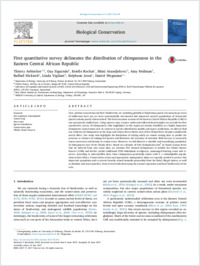First quantitative survey delineates the distribution of chimpanzees in the Eastern Central African Republic
- Aebischer, Thierry Department of Biology, University of Fribourg, Switzerland - Chinko Project, Bangui, Central African Republic
- Siguindo, Guy Chinko Project, Bangui, Central African Republic
- Rochat, Estelle Laboratory of Geographic Information Systems (LASIG), School of Architecture, Civil and Environmental Engineering (ENAC), École Polytechnique Fédérale de Lausanne (EPFL), Switzerland
- Arandjelovic, Mimi Max Planck Institute for Evolutionary Anthropology, Department of Primatology, Leipzig, Germany
- Heilman, Amy Max Planck Institute for Evolutionary Anthropology, Department of Primatology, Leipzig, Germany
- Hickisch, Raffael WildCRU University of Oxford, Department of Zoology, Tubney, UK
- Vigilant, Linda Max Planck Institute for Evolutionary Anthropology, Department of Primatology, Leipzig, Germany
- Joost, Stéphane Laboratory of Geographic Information Systems (LASIG), School of Architecture, Civil and Environmental Engineering (ENAC), École Polytechnique Fédérale de Lausanne (EPFL), Switzerland
- Wegmann, Daniel Department of Biology, University of Fribourg, Switzerland
-
01.09.2017
Published in:
- Biological Conservation. - 2017, vol. 213, no. Part A, p. 84–94
Pan troglodytes schweinfurthii
Camera trap
Nest count
Species distribution
Conservation plan
Chinko Nature Reserve
English
Vast, pristine ecosystems and their biodiversity are vanishing globally at frightening speed, but many large tracts of wilderness have not yet been systematically inventoried and important natural populations of threatened species remain poorly characterized. The forest-savanna ecotone of the Eastern Central African Republic (CAR) is one such poorly studied area. Using camera traps, transect walks and collected fecal samples, we provide the first quantitative survey of chimpanzees (Pan troglodytes) in this region previously classified as a highly important chimpanzee conservation unit. In contrast to species distribution models and expert predictions, we did not find any evidence of chimpanzees in the large and remote forest blocks west of the Chinko River despite considerable search effort. Our study thus highlights the limitations of relying solely on remote sensing data to predict the presence or absence of endangered species and illustrates the necessity of extensive field surveys to accurately assess occurrence and density in remote areas. However, we did discover a sizeable and reproducing population of chimpanzees east of the Chinko River. Based on a density of 0.81chimpanzees/km2 in closed canopy forest that we inferred from nest count data, we estimate 910 weaned chimpanzees to inhabit the Chinko Nature Reserve (CNR) and further predict additional 2700 individuals in adjacent, unmanaged hunting zones and reserves. According to microsatellite data, these chimpanzees genetically cluster with P. t. schweinfurthii populations in East Africa. Conservation action and appropriate management plans are urgently needed to protect this important population and to prevent heavily-armed nomadic pastoralists from the Sahel, illegal miners, as well as elephant and meat poachers, from irretrievably destroying the natural vegetation and local biodiversity of the area.
- Faculty
- Faculté des sciences et de médecine
- Department
- Département de Biologie
- Language
-
- English
- Classification
- Biological sciences
- License
- License undefined
- Identifiers
-
- RERO DOC 305621
- DOI 10.1016/j.biocon.2017.06.031
- Persistent URL
- https://folia.unifr.ch/unifr/documents/306101
Other files
Statistics
Document views: 90
File downloads:
- weg_fqs.pdf: 293
- weg_fqs_sm.pdf: 185
- weg_fqs_sm2.txt: 67


